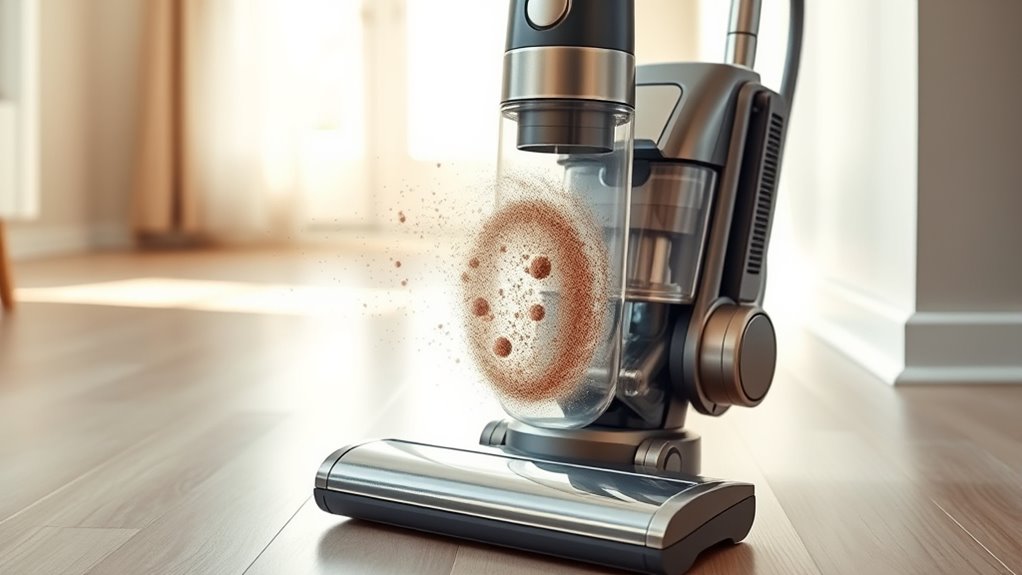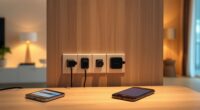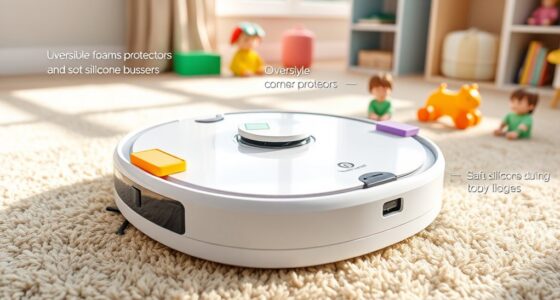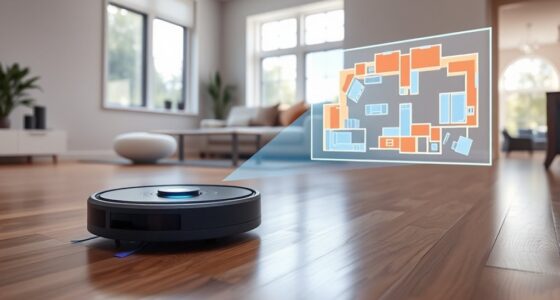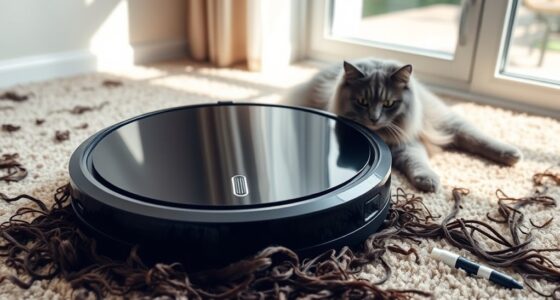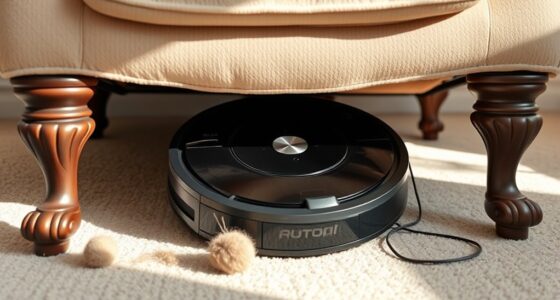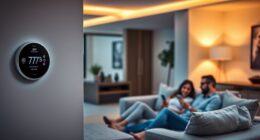Bagless vacuums can be beneficial for allergies if they have advanced features like HEPA filters that trap tiny allergens. Proper maintenance and careful disposal are key to preventing dust from escaping into the air. Many models also include sealed systems and filtration mechanisms that minimize airborne particles. While they can be effective, understanding how they contain allergens and maintain air quality can help you choose the right one—if you want to explore more, there’s plenty to discover.
Key Takeaways
- Bagless vacuums with HEPA filters effectively trap 99.97% of allergens, aiding allergy relief when properly maintained.
- Sealed dustbin systems in bagless models prevent allergen escape during disposal, reducing airborne dust.
- Proper emptying techniques and outdoor disposal minimize dust aerosolization and inhalation risks.
- Advanced filtration features like triple filters and UV-C lights enhance allergen and bacteria control in bagless vacuums.
- Regular cleaning and maintenance of filters and dust containers are essential for optimal allergen containment in bagless vacuums.
How Bagless Vacuums Capture Allergens
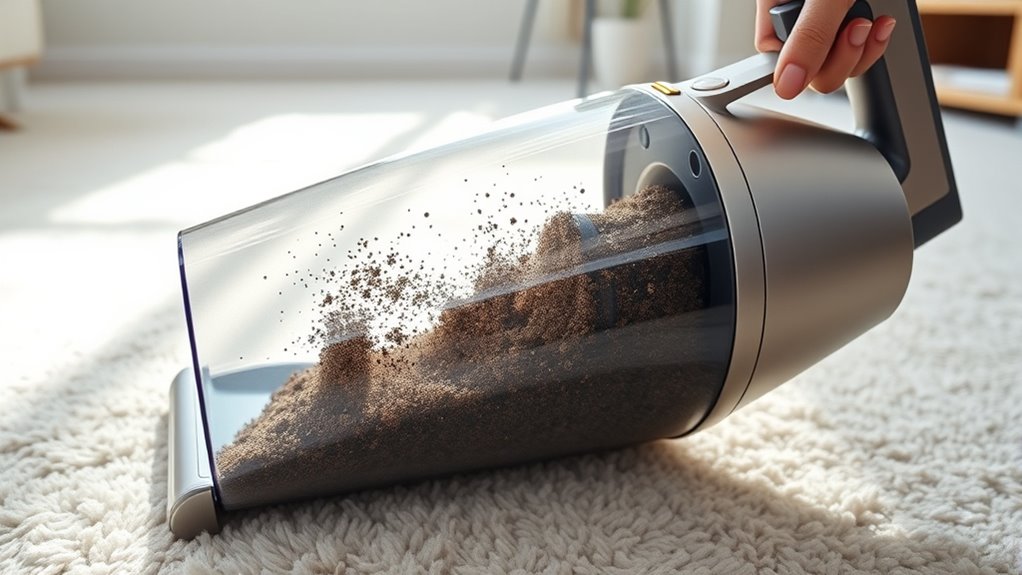
Bagless vacuums effectively capture allergens through a combination of design features and advanced filtration systems. When you vacuum, larger particles are first separated in the dust bin, while finer allergens travel toward the filter. Most models include HEPA or high-performance filters that trap particles as small as 0.3 microns, including dust mites, pollen, and bacteria. The system is often sealed, preventing dust and allergens from escaping during operation. Anti-allergen seals further lock in allergens inside the vacuum, ensuring they don’t leak back into your indoor air. As you vacuum, airflow is forced through these filters, capturing ultrafine particles and purifying the air you breathe. This design minimizes allergen escape, making bagless vacuums a strong choice for allergy sufferers. High-quality filters can trap 99.97% of particles as small as 0.3 microns, significantly enhancing allergen containment. Additionally, many models feature sealed system technology, which prevents allergens from leaking out during use.
Potential Risks of Dust Release During Emptying
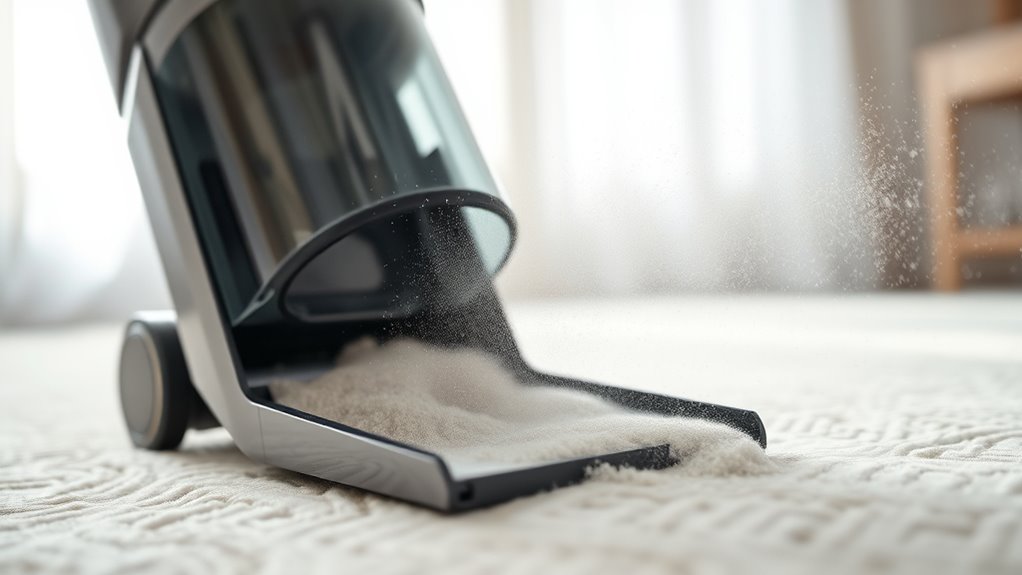
When you empty a bagless vacuum, dust can escape into the air, increasing your exposure to allergens and irritants. Handling the canister improperly or using rough techniques can aerosolize particles, making them easier to inhale. Using careful emptying methods and proper ventilation can help reduce these risks. Proper emptying techniques are essential to prevent the release of fine dust particles during the process. Additionally, understanding the air quality impact of dust release can motivate more cautious handling during disposal.
Dust Escaping During Disposal
Emptying a vacuum’s dust container can release airborne particles that pose health risks, especially for allergy sufferers. If not done carefully, dust clouds may form, dispersing allergens like dust mites and pollen. Static electricity can also cause dust to cling to the outside of the bin and vacuum surfaces, increasing exposure. Some models have features like one-step release mechanisms or sealed containers to minimize dust escape. Proper emptying techniques, such as doing it outdoors or gently opening the bin, help reduce dust clouds. The table below highlights the importance of design features:
| Feature | Effect | Best Practice |
|---|---|---|
| Tight-sealing lids | Limit dust escape | Use models with sealed lids |
| HEPA filters | Trap microscopic allergens | Regularly replace filters |
| Bottom-release bins | Direct debris disposal | Empty outdoors or in ventilated areas |
Additionally, anti-static coatings can help reduce dust cling during disposal. Employing dust management strategies can further minimize allergen release during disposal.
Aerosolized Particles Risks
Dust released during vacuum disposal can pose considerable health risks due to aerosolization of tiny particles. When you empty a bagless vacuum, fine dust and allergens become airborne, increasing your inhalation risk. HEPA filters help, but they don’t fully contain all particles, especially during emptying. Leading bagless models emit over 175,900 lung-damaging particles per minute, and some can be sensed by smell or taste, confirming airborne dust exposure. Tiny particles as small as 0.3 micrometers, including dust mite feces, pollen, and pet dander, remain suspended during disposal, triggering allergies and asthma. Without a sealed system, dust leaks back into your indoor air, heightening respiratory risks. Proper emptying techniques and sealed containers can significantly reduce dust escape during disposal, helping to protect your lungs and allergies. Using air filtration systems can further improve indoor air quality by capturing airborne particles during and after vacuuming.
Handling and Emptying Techniques
Handling the emptying process carefully is essential to prevent releasing dust and allergens into your indoor air. If you shake or tap the canister indoors, dust and fine particles can billow out, creating a visible cloud of allergens. To minimize this, empty the canister outside, away from living spaces, and wear a mask if you’re sensitive. Gently dislodge debris without excessive agitation, and seal the dust in a garbage bag promptly after outdoor disposal. Avoid indoor tapping or shaking, as these increase dust release. Regularly cleaning filters and canisters reduces dust buildup and minimizes risks during emptying. Proper technique and precautions help protect allergy sufferers from inhaling airborne allergens and prevent worsening symptoms caused by dust re-exposure during vacuum maintenance. Additionally, dust and pollutants are released when canisters are emptied into trash, so outside disposal is recommended to prevent indoor air contamination. Using dust containment methods further reduces the risk of allergen dispersal during disposal.
Filtration Technologies in Bagless Models
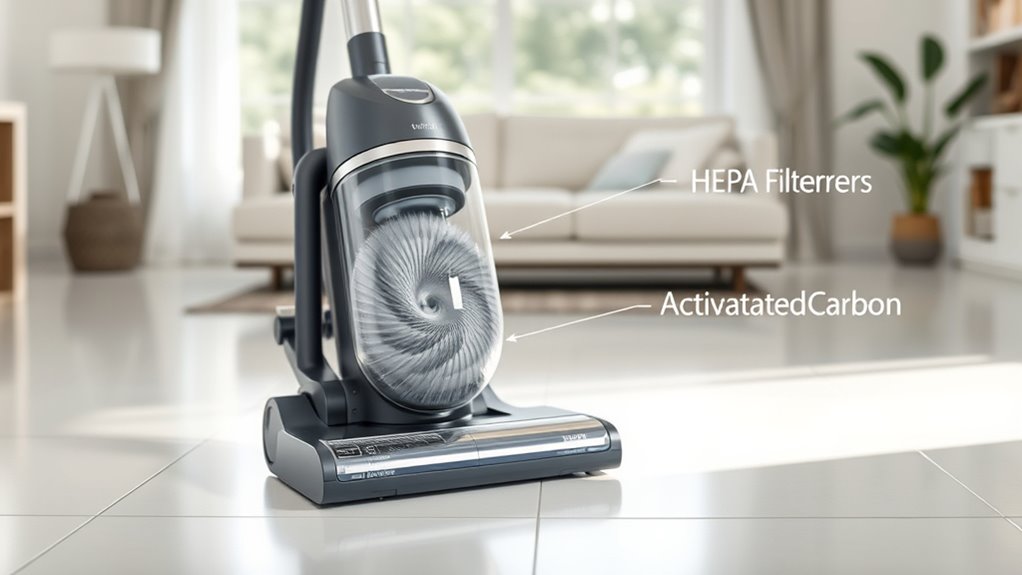
HEPA filters in bagless vacuums can trap at least 99.97% of tiny allergens, making them a key tool for allergy sufferers. However, their effectiveness depends on proper maintenance, as clogged filters lose efficiency. To prevent dust release during emptying, many models include features like sealed dustbins or one-touch disposal, helping keep allergens contained. Regular filter cleaning is essential to maintain optimal filtration performance over time, especially since filter types play a crucial role in allergen control.
HEPA Filter Effectiveness
Filtration technologies in bagless vacuums rely heavily on the effectiveness of HEPA filters to trap airborne allergens. True HEPA filters remove at least 99.97% of particles 0.3 microns and smaller, effectively capturing pollen, pet dander, dust mites, mold spores, and smoke. To maximize performance, ensure your vacuum has a sealed system where all air passes through the filter before exhaust. Sealed systems prevent dust and allergens from escaping back into your home. Regular maintenance of filters and dustbins is essential for sustained effectiveness. Combining pre-filters with HEPA filters extends filter lifespan and enhances air purity. Proper filtration system design is vital for allergy relief in bagless vacuums.
Dust Release Prevention
To prevent dust from escaping into the air during emptying, bagless vacuum models incorporate various dust containment mechanisms. Sealed dustbins with one-way valves trap dust inside, reducing airborne particles. Conical shapes guide debris downward, minimizing dust stir-up during disposal. Anti-static coatings inside the bin help dust resist adhesion, easing emptying and lowering dust clouds. Some models feature dust shrouds or covers over the opening for controlled emptying. Filters placed after the dustbin capture fine particles that escape during disposal, further preventing dust release. Advanced sealing technology ensures minimal dust escape during maintenance. Additionally, ergonomic design can make the emptying process easier and cleaner for users. Maintaining these systems is vital; dirty filters or poorly designed dustbins can increase dust escape. Regular cleaning and proper handling ensure dust stays contained, making bagless vacuums safer for allergy sufferers. These innovations help reduce allergen exposure during vacuum maintenance.
Comparing Allergen Containment: Bagless vs. Bagged
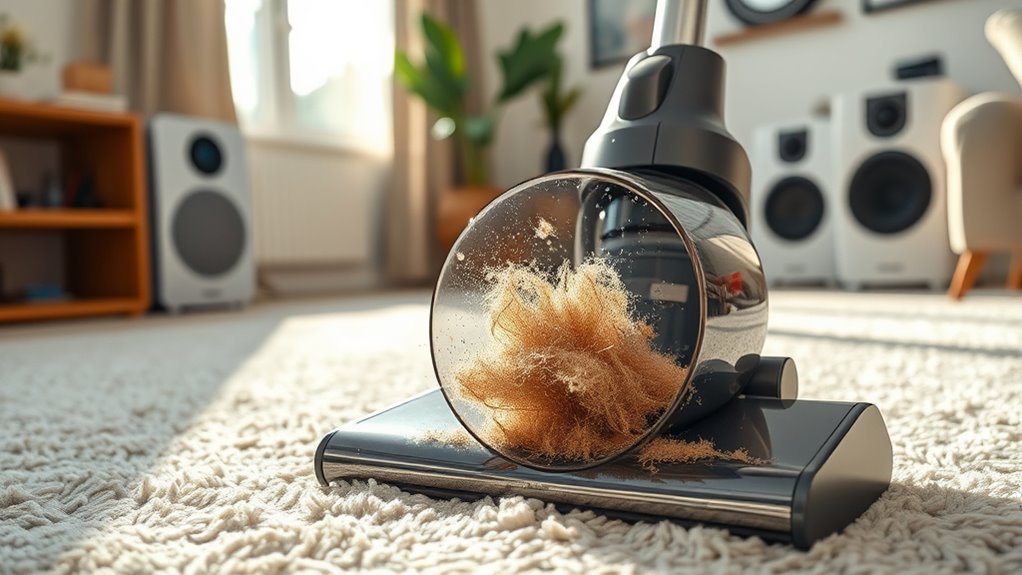
When it comes to allergen containment, bagged vacuums generally offer better performance than bagless models. They trap dust, dirt, and allergens more effectively with sealed bags that prevent particle escape during use and disposal. This containment reduces airborne allergens and minimizes exposure. Consider these points:
- Sealed bags trap 99.97% of particles as small as 0.3 microns, surpassing many filters.
- Bagged systems reduce allergen release during disposal, unlike bagless vacuums, which often puff dust back into the air.
- HEPA filters in both types are more effective when paired with sealed bags.
- Less frequent filter maintenance in bagged vacuums keeps allergens contained longer, maintaining cleaner indoor air.
- Properly sealed bags prevent dust from escaping during disposal, further improving allergy protection and maintaining overall air quality.
Maintenance and User Practices for Allergy Safety
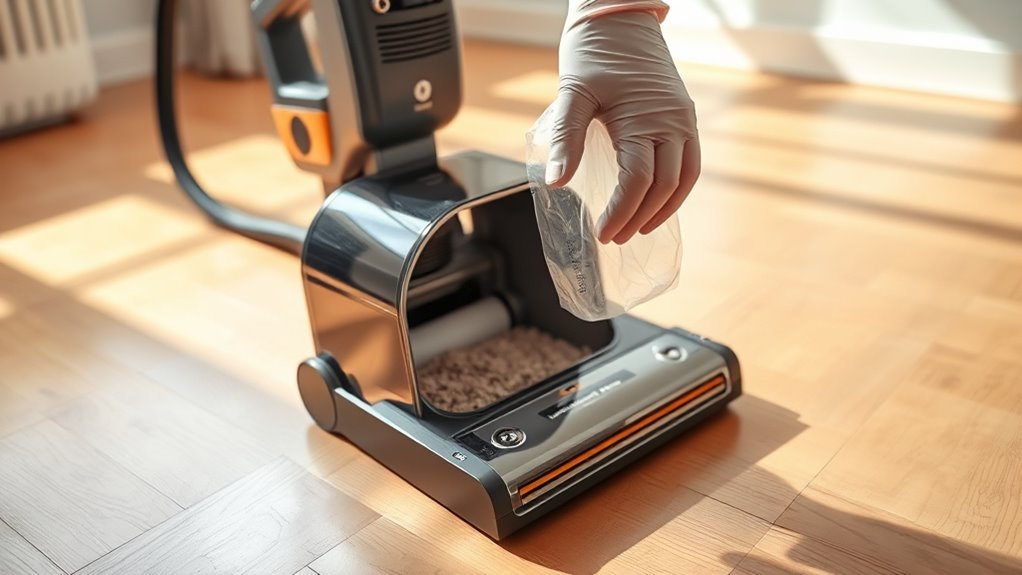
Proper maintenance and user practices play a pivotal role in ensuring allergy safety when using vacuums. When emptying a bagless vacuum, use bottom-empty tanks or slide-lever disposal systems to minimize dust clouds. Empty the bin outdoors or in a well-ventilated area, and wear a high-efficiency mask if you’re highly sensitive. Consider having someone without allergies handle emptying when possible. Regularly clean and replace HEPA filters to prevent allergen release; some models have lifetime filters that require less maintenance. After emptying, wipe the dust container with a damp cloth to trap residual dust. Inspect seals and clean brushes and attachments frequently to prevent allergen buildup. Using airtight disposal methods and scheduling cleaning when allergy sufferers aren’t present further reduces exposure risks. Proper maintenance also includes checking for cracks or damage in the vacuum’s seals to prevent dust leakage during operation. Implementing HEPA filtration can significantly improve air quality during and after vacuuming.
Impact of Vacuum Design on Indoor Air Quality
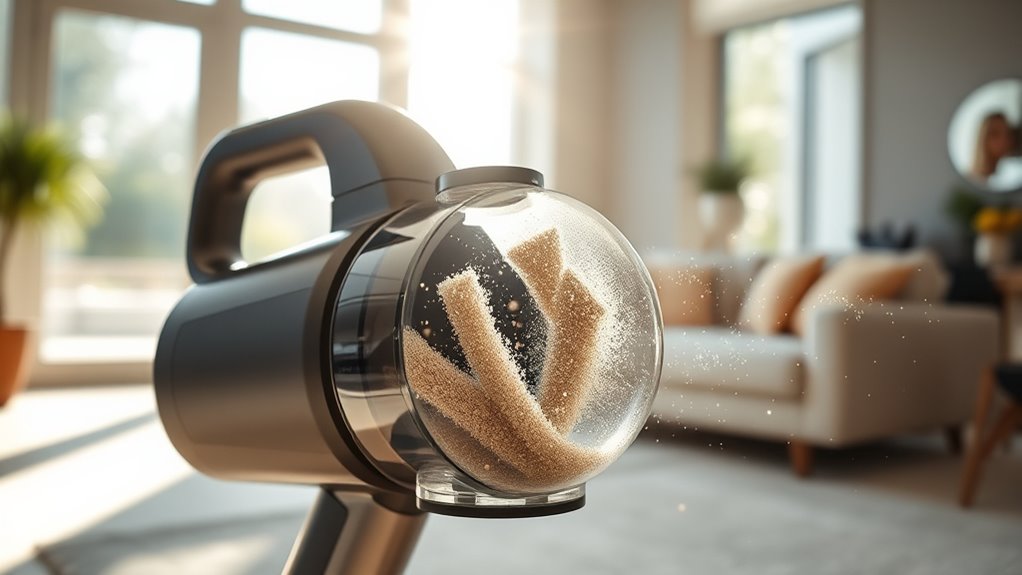
The design of your vacuum considerably influences indoor air quality, especially regarding dust containment and allergen release. A well-designed vacuum minimizes dust escape and prevents allergens from recirculating. Here are key factors to consider:
- Bagged vacuums typically contain dust better, reducing release during disposal.
- HEPA filters are vital in trapping fine particles, but some bagless models still emit more allergens than top-tier bagged vacuums.
- Proper sealing prevents dust leakage back into the air, improving indoor air quality.
- The method of dust disposal affects allergen exposure—bagged vacuums often offer more hygienic emptying.
Choosing a vacuum with sealed filtration, efficient dust containment, and careful disposal can substantially reduce airborne allergens and improve your indoor environment.
Studies on Allergen Levels in Vacuum Dust
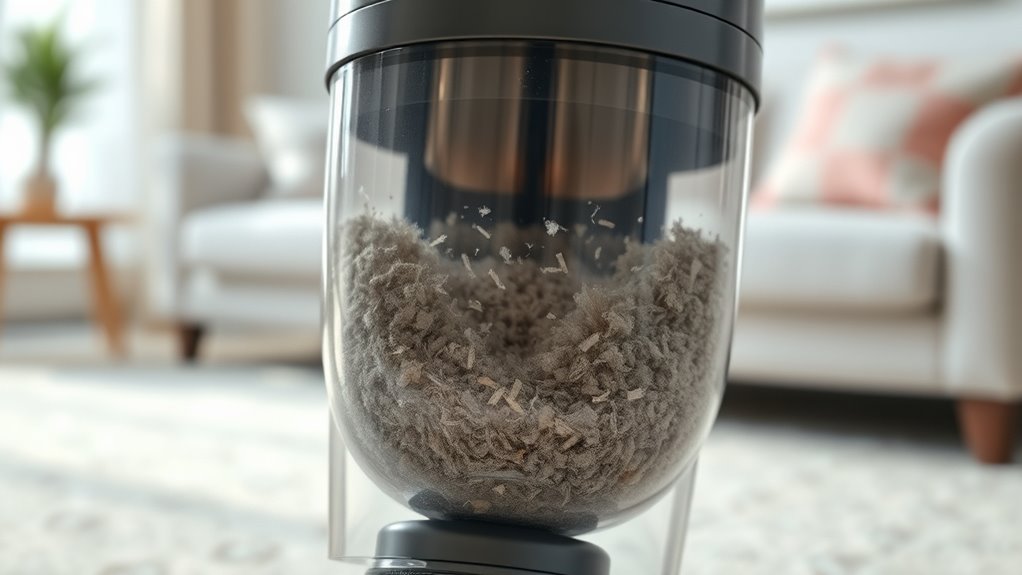
Numerous studies have established a strong link between allergen levels found in vacuum dust and the concentration of allergens present in indoor air. They show that allergen concentrations in vacuum dust bags strongly correlate with dust samples from specific rooms, with correlation coefficients ranging from moderate to very strong. Dust mite allergens, however, have weaker correlations due to their association mainly with bedding and larger particle size, which limits airborne presence. Vacuum cleaning can temporarily raise airborne allergen levels, especially during operation, but doesn’t considerably differ between new and old vacuums. Variability in dust composition, such as inert materials and cleaning agents, can affect allergen measurements. Overall, vacuum dust serves as a useful indicator of long-term allergen exposure, though its accuracy depends on sample composition and allergen type. Additionally, the type of vacuum filter used can influence the amount of allergens trapped and released during cleaning, impacting indoor allergen levels.
Recommendations for Allergy Sufferers
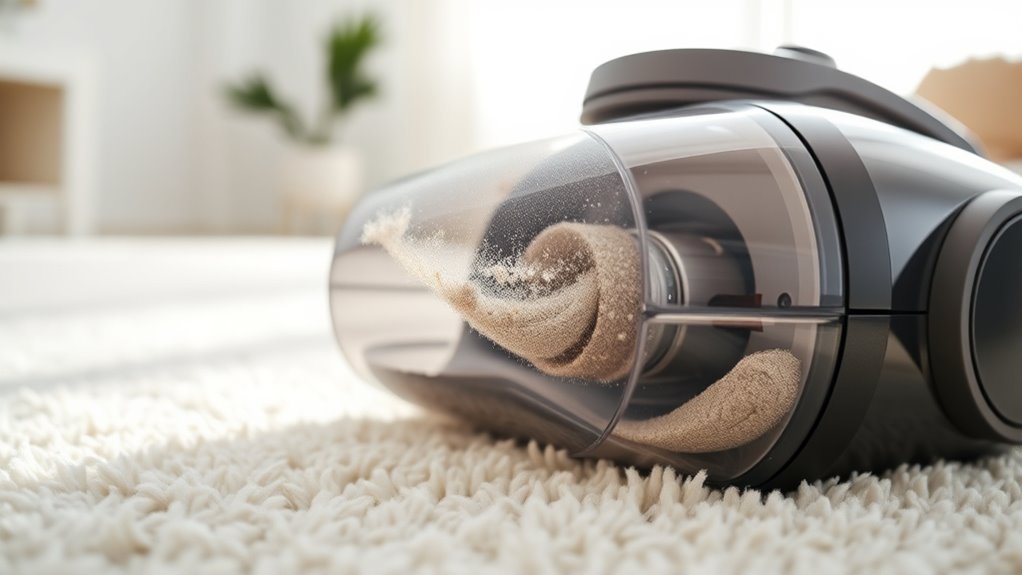
For allergy sufferers, choosing the right vacuum cleaner can make a significant difference in indoor air quality and symptom management. To minimize allergen exposure, prioritize vacuums with these features:
- HEPA filters that capture 99.97% of particles down to 0.3 microns, reducing fine allergen release.
- Sealed, multi-layer dust bags that contain dust and allergens during disposal, avoiding airborne release.
- Self-sealing or “No Touch” disposal systems to eliminate contact with dust clouds when emptying.
- Additional filters like activated carbon or UV-C lights to further reduce airborne allergens.
Implementing these features can significantly improve allergen containment and reduce symptoms. Regular maintenance and proper disposal are essential for keeping indoor air clean and managing allergy symptoms effectively.
Advances in Bagless Vacuum Features for Better Allergen Control
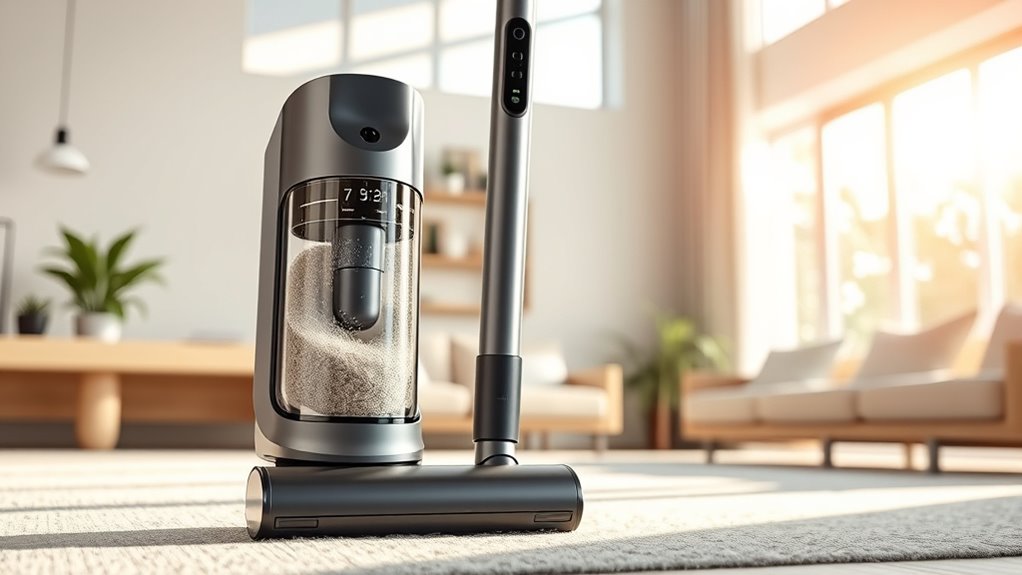
Advances in bagless vacuum features have particularly improved allergen control by incorporating sophisticated filtration and sealing technologies. Many models now use triple filtration systems, like Bosch ProHygienic, which capture 99.99% of airborne irritants with UltraAllergy filters. HEPA filters, often optional, trap particles as small as 0.3 microns, while airtight seals prevent allergen escape during operation. New models also feature anti-allergen seals that work with HEPA filters to minimize dust release during vacuuming and emptying. Redesigned dustbins reduce spillage and include mechanisms to release dust with less exposure. Some models add activated carbon filters for odors and UV-C light to kill bacteria. These innovations help contain allergens more effectively, making bagless vacuums a better choice for allergy sufferers. The inclusion of UV-C light can also help reduce bacterial growth inside the vacuum. However, careful maintenance remains essential for maximum performance.
Frequently Asked Questions
Do Bagless Vacuums Actually Release More Allergens During Emptying?
You might wonder if bagless vacuums release more allergens when you empty them. The answer is yes, they can, especially if the dust container isn’t well-sealed or lacks high-quality filters. When you empty these vacuums, dust clouds can escape, exposing you to allergens. To minimize this, choose models with sealed systems, HEPA filters, and proper emptying features, and always empty carefully to avoid stirring up dust.
How Effective Are HEPA Filters in Bagless Vacuum Models?
When it comes to HEPA filters in bagless vacuums, they’re a real game-changer for allergy sufferers. These filters can trap at least 99.97% of tiny particles, including pollen, dust mites, and pet dander, if the system is sealed properly. Just remember, a well-designed sealed system is key—otherwise, dust can sneak out and reduce effectiveness. With regular maintenance, HEPA filters in bagless vacuums can keep your indoor air cleaner.
Can Regular Emptying of Bagless Vacuums Reduce Allergen Exposure?
Regularly emptying your bagless vacuum can substantially reduce allergen exposure. When you do it carefully and consistently, you prevent dust and allergens from building up, which helps maintain better indoor air quality. Always empty outdoors or in well-ventilated areas, and handle the bin gently to minimize releasing allergens. Using protective gear and following proper maintenance routines ensures you’re less likely to inhale trapped dust, pollen, or pet dander.
Are There Specific Bagless Vacuum Features That Minimize Allergen Release?
Did you know that sealed dust bins can reduce allergen release by up to 80%? When shopping for a bagless vacuum, look for features like sealed chambers, tight-fitting lids, and no-touch emptying options. These design elements help contain dust and allergens during disposal. Regularly maintaining filters and following proper emptying procedures also keep allergens at bay, making your home safer and more comfortable for allergy sufferers.
How Do Bagless Vacuums Compare to Bagged Ones in Allergy Management?
You want to compare bagless and bagged vacuums for allergy management. Bagged models typically trap allergens better with sealed bags and specialized filters, preventing dust from escaping during disposal. Bagless vacuums often use filters but risk releasing allergens when emptying the dustbin. For better allergy control, a bagged vacuum with sealed bags and high-quality filters generally offers superior containment and cleaner air, especially for allergy sufferers.
Conclusion
Ultimately, understanding the strengths and sneaky shortcomings of bagless vacuums helps you make smarter choices. By mastering maintenance, maximizing filtration, and mindful emptying, you can minimize dust and dampen allergens in your domain. With careful cleaning and clever technology, you can confidently combat contaminants and create a cleaner, healthier haven. So, stay savvy, select superior systems, and safeguard your space—because a allergen-aware approach keeps your home happily healthy.
